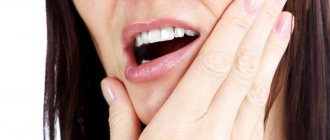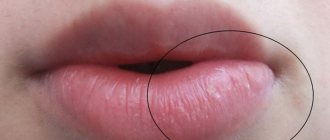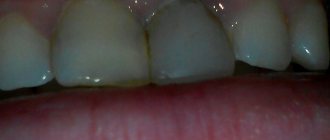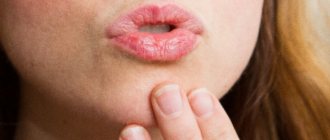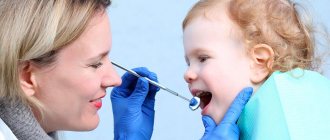Swelling of the upper lip in a child indicates the development of pathological processes in the body that require mandatory treatment.
This article discusses the main causes, symptoms and treatment methods depending on the etiology of edema. Possible complications and prevention of this condition in a child are also described.
Why is my child's upper lip swollen?
A swelling on a child’s lip cannot occur on its own. This signals the emergence of some problems that affect the baby’s health.
To prevent them, it is important to correctly and timely identify the factors that provoked swelling.
Among them, experts highlight:
- It is important to correctly and timely identify the factors that provoked swelling
Allergy, as a reaction to certain foods , oral hygiene products. This is also how the body can react to taking certain medications or the presence of orthodontic structures in the mouth.
- Insect bites provoke swelling of the mucous membranes of the lips, as a result of individual allergies.
- Teething may be accompanied by slight swelling of the baby's lips.
- Traumatic injury. In addition to mechanical damage, a swollen lip in a child can cause frostbite, chapping, or burns.
- Pathologies of systemic viral, infectious or bacterial origin. Most often, the body reacts this way to ARVI, herpes infection, or acute respiratory infections.
- Dental diseases: periodontal disease, stomatitis of any etiology, periodontal disease, periostitis.
- Dentist mistakes. Incorrect treatment or poor quality dental procedures can cause lip swelling.
- Inflammation. This symptom is characteristic of many diseases, or may be a response to a lip injury.
Important! If the swelling of the lip is caused by an inflammatory process, then the presence of accompanying symptoms is mandatory. This may include hyperthermia, soreness and a change in color. Also, depending on the etiology, ulcers may appear on them. - The habit of biting your lip provokes constant mechanical damage, which becomes the main cause of the formation of microcracks and wounds with subsequent infection.
- Hygiene problems. Children begin to learn about the world through their mouths, so it is impossible to maintain proper hygiene of the oral cavity and all objects that the baby puts into his mouth. The entry of bacteria into the mouth provokes the development of inflammatory processes, which can cause the lip to swell.
Causes
Often a child gets sick for the first time during teething. It prevents you from brushing the area where the tooth is erupting. As a result, infection accumulates in this place and inflammation of the gum tissue occurs, which gradually spreads. It is aggravated by frequent allergic reactions to introduced complementary foods.
In older children, pathology is provoked by the following reasons:
- mechanical microtraumas - damage to gum tissue occurs when brushing teeth with hard brushes or hard food when biting it;
- the introduction of herpes is provoked by other viral or infectious lesions of the oral cavity;
- the presence of polyps in the nasal cavity and breathing problems contribute to the penetration of an infectious agent into the gum tissue;
- an incorrect bite in a child leads to constant trauma to the mucous membrane and the development of inflammation;
- lack of nutrients, vitamins and microelements in the baby’s diet reduces local immunity;
- the manifestation of a viral infection is provoked by burns in the mouth;
- Dental diseases (caries, pulpitis) contribute to the development of the virus in the gum tissue, weakening local immunity.
The infection spreads to other tissues quite quickly, and isolated gum damage spreads to periodontal structures.
Symptoms
In medical practice, swelling on the lips can be localized in any area. Most often in children, its upper part swells. But, regardless of where the swelling is located, this condition can be a sign of a life-threatening condition.
The appearance of swelling on the upper lip, depending on the etiology, may be accompanied by the following symptoms:
- Regardless of where the swelling is located, these symptoms may be a sign of a life-threatening condition.
The anatomical shape of the lips changes.
- Rapid and sudden development of a tumor.
- The appearance of swelling of the mucous membranes of the tongue and oral cavity.
- There is an unpleasant odor from the mouth.
- Increased pain on palpation of the lip and area under the nose.
- Labored breathing.
- Itching sensation on the lips, throat or mouth.
- The skin began to darken and acquire a blue tint.
- High body temperature, chills, fever.
- Sensation of a foreign object in the throat.
- There may be small pimples and blisters on the lips.
Important! If a child shows the slightest sign of swelling on the upper lip, it is necessary to immediately seek qualified medical help. The specialist will be able to correctly determine the cause of swelling and prescribe appropriate treatment to stabilize the child’s condition.
Associated symptoms and what do they indicate?
In addition to the main symptoms, swelling of the lips in a child is always accompanied by additional symptoms.
According to the accompanying manifestations, the diagnosis is made easier:
| Sign | What does it indicate? |
| Temperature | The development of both general and local hyperthermia indicates an infectious etiology of the disease and the appearance of inflammation. |
| Only the middle of the lip is swollen | The formation of an abscess as a result of mechanical trauma to the soft tissues and pulp of the tooth. |
| My lip is very swollen | For the occurrence of an allergic reaction in the form of Quincke's edema, disruption of the functionality of the salivary glands, or severe injury and insect bites. |
| Swollen lower lip | For the appearance of neoplasms of various etiologies, the development of angioedema or allergic edema. And also for mechanical injury to the integrity of the lip. |
| The lip is festering | This sign is a symptom of bacterial infection of the oral cavity, the development of purulent stomatitis, cheilitis, type 1 herpes, or the presence of closed acne. |
Important! Regardless of the visual signs, to make an accurate diagnosis it is necessary to undergo a full examination, which includes laboratory testing.
What is periostitis and how does it manifest in children?
The disease is usually a consequence of advanced dental problems, when inflammation descends, spreading to the bone. In children, this process can happen very quickly - sometimes the hours count.
In everyday life, periostitis of the jaw is called gumboil
. It is usually acute in nature and manifests itself with the following symptoms:
- complaints of jaw pain;
- asymmetrical swelling, puffy cheek;
- enlarged lymph nodes in this area;
- increase in general body temperature;
- weakness of the child, signs of general intoxication.
Please note that with periostitis, cooling the inflamed area reduces pain, and heating
increases discomfort.
Look at photos of children with periostitis - you will notice that the face is asymmetrical, the cheek or cheekbone area is swollen and looks painful.
The symptoms listed above (one or more) should be a guide to immediate action - it is necessary to urgently take the child to the dentist. It should be noted that in this case a prior appointment is not required - at the municipal clinic you will be seen immediately with a note of “acute pain”.
Diagnostics
To make an accurate diagnosis and identify the causes of the disease in case of swelling of the upper lip in a child, it is necessary to undergo a timely medical examination.
If rapid swelling occurs, you must urgently call an ambulance or consult an allergist yourself. This condition is dangerous because swelling of the throat can develop, which can result in asphyxia, which can be fatal.
If swelling appears gradually and is accompanied by additional sensations, to eliminate them, you may need the help of doctors such as:
- An examination by any doctor begins with a visual examination.
Dentist.
- Pediatrician.
- Infectious disease specialist.
- Maxillofacial surgeon.
- Otolaryngologist.
- Oncologist.
An examination by any doctor begins with a visual examination. Then, taking into account the clinical picture, specialists prescribe a series of examinations.
Among them it is worth highlighting:
- Laboratory tests: clinical blood test, flora smear, general blood test, biopsy, biochemical blood test.
- Hardware examination: radiography, ultrasound, MRI or computed tomography.
Important! Timely and complete diagnosis of the pathology will allow you to choose the right treatment. This will significantly reduce the child’s recovery time.
Diagnosis and treatment of gingivitis in young children
Gingivitis in children is diagnosed during a standard dental examination. If a visual examination is not enough to make a diagnosis, the doctor may order an x-ray.
Treatment of gingivitis in children under one year of age
and older requires an integrated approach. The course of prescriptions is selected individually, taking into account the form of the disease and the age of the small patient.
Complex treatment of gingivitis in children under 2
years and older:
1. Removing soft microbial plaque and hard dental deposits from the surface of teeth.
2. Polishing tooth enamel with special brushes.
3. Antiseptic mouth rinses.
4. The use of anti-inflammatory gels and ointments to treat inflamed gums.
5. Sanitation of the oral cavity. When gingivitis is diagnosed,
treatment in children 3 years of age
and younger is based on gentle techniques. For example, to remove carious formations, teeth are silvered without drilling.
In severe forms of gingivitis with a high risk of complications, antibacterial agents are included in drug therapy. The drug and dosage are selected by the attending dentist.
When diagnosed with gingivitis, treatment in children (4 years
and younger) with the use of antiseptic solutions for rinsing the oral cavity is successfully replaced by applications using cotton swabs soaked in a medicinal composition. This recommendation is relevant if the baby refuses or cannot independently perform the mouth rinsing procedure.
What to do if your lip is swollen - treatment, depending on the cause
If there is swelling on the lip, the therapeutic complex is selected taking into account the main factors that provoked this condition in the baby.
The doctor also takes into account the child’s age and his individual physiological characteristics of the body and health in general.
What to do if your lip is swollen:
- The doctor takes into account the child’s age and his individual physiological characteristics of the body and health in general.
Herpes virus , in which the mucous membranes are covered with small ulcers and blisters: treatment with peroxide, furatsilin solution, levomikol ointment.
- An allergic reaction is treated with general and local antihistamines.
- Tramming. The damaged area is treated with a disinfectant. Afterwards, the use of wound-healing ointments, essential oils, and propolis is allowed.
- Dental pathologies and errors are treated exclusively by specialists in a specialized clinic.
Important! In most cases, as a universal aid, if a child’s lip is swollen, doctors recommend rinsing the mouth with antisemitic drugs and herbal decoctions.
How to relieve swelling?
When treating swelling of the upper lip in a child, medical practice uses drugs and traditional medicine that have decongestant, anti-inflammatory, antiseptic, antihistamine, and analgesic effects.
Among pharmacological drugs, particular effectiveness is observed in complex treatment, consisting of oral and local medications:
- Self-prescription and incorrect dosage can not only aggravate the development of edema, but also reduce the overall health of the baby
General drug therapy, depending on the etiology of the cause of swelling , consists of using tablet drugs: Suprastin, Ibuprofen, Rimantadine, Anaferon, Gerpivir.
- Local therapy has a symptomatic effect and stimulates tissue regeneration. Most often in pediatrics, when a child has swollen lips, the following are prescribed: Stomatidin, oxalic ointment, Acyclovir, brilliant green solution, Lamisil, hydrogen peroxide.
- Natural medicines recommended by naturopaths are prepared based on herbal ingredients. Most often in this case they use: aloe juice and pulp, decoctions of medicinal herbs, herbal infusions, beekeeping products, Fuller's earth, baking soda. In addition to the local use of folk remedies, children are recommended to drink herbal teas to strengthen general immunity.
Important! The prescription of medicines and folk remedies should be carried out exclusively by a pediatrician based on the results of the examination. Self-prescription and incorrect dosage can not only aggravate the development of edema, but also reduce the level of overall health of the baby.
Causes of dental periostitis in children
As already mentioned, this disease is usually secondary and caused by inflammatory processes in the teeth (odontogenic periostitis). What problems can lead to damage to the periosteum?
- dental caries with inflammation of the pulp;
- periodontitis;
- injury to the tooth or jaw.
Inflammation from the soft tissue area spreads deeper, involving the periosteum (fluss = “flow” in German, which perfectly characterizes the infection process).
Types of periostitis of the jaw in children
According to the course of the disease, acute and chronic forms are distinguished. It should be noted that the second is very rare.
Acute periostitis in children is usually purulent in nature - exudate forms under the periosteum, significantly changing the shape of the face, making it asymmetrical. Other symptoms of the disease are described above - increased body temperature, complaints of pain, swollen gums, etc. If the gums are soft and loose, then this is a different case.
Any manifestation of inflammatory processes in the teeth and jaws should be a signal to go to the hospital. And acute purulent periostitis
is a signal to provide immediate assistance
.
The chronic form is manifested by an increase in periosteal tissue, which outwardly looks like a slightly asymmetrical jaw. This usually does not cause discomfort to the child. However, you need to consult a dentist - perhaps dental treatment will help remove the source of inflammation, which will lead to a gradual return of the periosteum to its original healthy state.
Which doctor should I contact for flux?
Inflammatory processes in the oral cavity, including periostitis, are treated by a dentist. You can go to a municipal clinic or a private center. In the dental clinic at your place of residence, you will be provided with assistance under the child’s compulsory medical insurance policy
.
If the flux manifests itself on a day off, find the contacts of on-duty municipal clinics in your city. Typically, several offices in different areas are open on Saturdays and Sundays.
Or go to a private clinic. In this case, flux treatment may be a little more pleasant, since such organizations are equipped taking into account the mental characteristics of children. The child may be shown a cartoon during the procedure. The staff of private clinics is specially trained to work with young patients. Prices for the treatment of periostitis should be clarified by calling a specific organization.
How is acute periostitis treated in children?
Treatment of the acute form of the disease is possible only with a doctor. No folk remedies, lotions or rinses can defeat flux - it can only make it worse. Separately, it is worth mentioning the dangers of warming up. Heating the painful area can increase the rate at which inflammation spreads, leading to unpredictable consequences. Warming up the flux is strictly prohibited!
Treatment of acute, including purulent, periostitis in children includes, first of all, opening the abscess and removing pus. The gums and periosteum are cut, under which exudate has accumulated. In some cases, drainage is required. The tip of a latex strip is inserted into the wound, which prevents the incision from closing quickly and allows all the pus to leak out. The procedure seems unpleasant, but it is well tolerated.
The doctor also carries out manipulations aimed at minimizing the source of initial inflammation.
In advanced cases, hospitalization will be required.
Also, after opening the wound, draining and sanitizing the oral cavity, the doctor will prescribe antibacterial therapy, possibly immune-supporting drugs.
Children who have undergone treatment for periostitis are advised to drink plenty of fluids, rest, and eat right.
The diet should contain a sufficient amount of protein, vitamins, minerals - calcium, magnesium, iron and others.
Treatment of chronic periostitis in children
This form of the disease is extremely rare in minors. Treatment of chronic periostitis in children is aimed at removing the source of inflammation, reducing tissue proliferation by activating immune processes. Physiotherapeutic procedures are prescribed; in advanced cases or if conservative therapy is insufficiently effective, surgical intervention is possible.
Possible complications
Most often, a swollen upper lip in a child, with timely and correct medical care, does not pose a danger to the health, much less the life of the child. In most cases, swelling goes away and leaves no negative consequences.
But it is worth noting that neglecting the baby’s condition or not following medical prescriptions can provoke the development of the following negative consequences:
- In most cases, swelling goes away and leaves no negative consequences.
Having a large scar.
- Eczema in an advanced stage.
- Development of sepsis.
- Life-threatening infection.
- The spread of herpes rash not only over the entire lip area, but also on the face.
- Rapid development of Quincke's edema during an allergic reaction.
- The appearance of a malignant neoplasm.
Important! To prevent the development of complications, treatment of lip swelling in a child must begin at an early stage.
Preventive measures
You can easily prevent the development of puffiness on your lips.
To do this, the following preventive measures must be observed:
- Consume exclusively clean foods.
- Keep your hands and mouth clean.
- Drink vitamin complexes systematically.
- During seasonal exacerbations, take antiviral drugs.
- Avoid trampling.
- Have regular dental checkups.
- Treat dental pathologies in a timely manner only from trusted specialists.
- For allergy sufferers, avoid contact with allergens and always carry antihistamines with you.
- Avoid psycho-emotional stress.
- Minimize stressful conditions.
Important! The main thing in preventing swelling of the upper lip in a child is its regularity. Only with this approach is it possible to avoid the appearance or recurrence of this condition.
Swelling of the lip in a child is not always an independent disease. In most cases, this is a clear sign of more serious pathologies. Therefore, if even the slightest swelling occurs, you must immediately consult a doctor.

